WASHINGTON, D.C. -- Underemployed Americans are significantly more likely to be "struggling" (54%) than employed Americans (38%), according to the Gallup-Healthways Well-Being Index. Those who are underemployed are also less likely to be "thriving," than those who are employed -- 42% versus 61%.
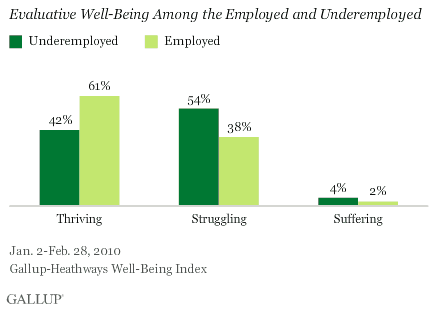
These results are based on January and February interviews with approximately 40,000 adults in the U.S. workforce, age 18 and older. Gallup classifies respondents as "employed" if they are employed full time or are employed part time but do not want to work full time. Respondents are considered "underemployed" if they are employed part time but want to work full time or are unemployed. Gallup categorizes Americans as thriving, struggling, or suffering according to how they rate their present and future lives on a ladder scale, with steps numbered from 0 to 10, based on the Cantril Self-Anchoring Striving Scale.
"Underemployed Americans are almost twice as likely to have been told by a doctor or nurse that they suffer from depression."
Majorities of the unemployed (57%) and those who work part time but want to work full time (52%) are struggling, while majorities of respondents working at their desired capacity are thriving. This finding illustrates that in terms of wellbeing, Americans working part time but wanting full-time employment are more similar to the unemployed than the employed.
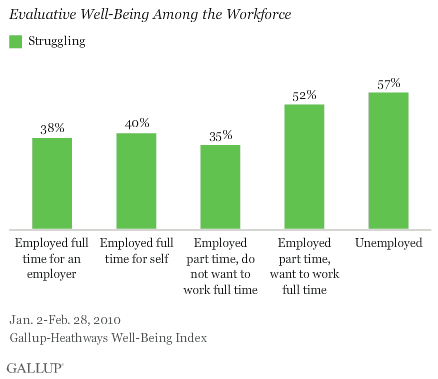
Worry and Stress Pervasive Among Underemployed
In addition to a more pessimistic outlook on their present and future lives, underemployed respondents are also more likely than the employed to report experiencing negative emotions. Nearly half (46%) of underemployed Americans said they experienced worry the day before the surveyed, compared with 29% of the employed who said the same. The underemployed are also more likely than the employed to report experiencing sadness, stress, and anger.
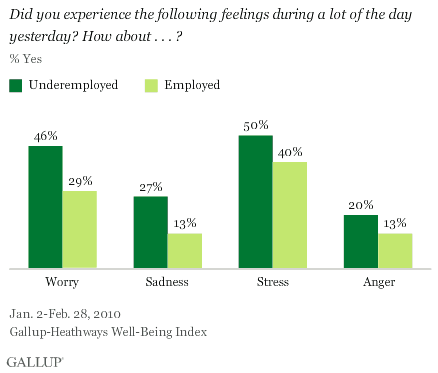
Underemployed Americans are also almost twice as likely to have been told by a doctor or nurse that they suffer from depression (21% versus 12% employed Americans).
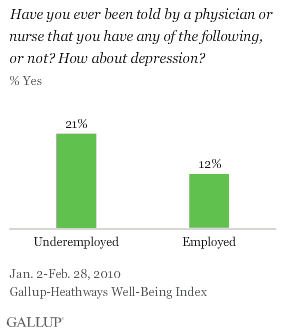
Underemployment does not appear to be taking as much a toll on the experience of positive emotions as it does on negative emotions. A significant majority of all respondents -- regardless of employment status -- reported positive emotions during the previous day. Underemployed individuals are slightly less likely than employed respondents to experience happiness and enjoyment, with nearly six percentage point differences in terms of happiness and enjoyment.
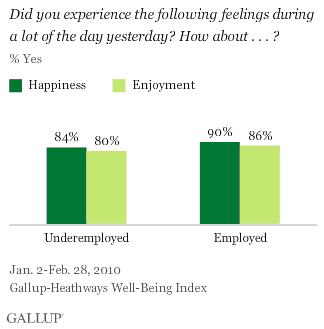
A Silver Lining
One potentially favorable difference to emerge from the data is that the underemployed report spending more social time per day with family and friends than the employed. Fifty-one percent of the underemployed reported spending at least six hours socializing with family and friends on the day before the survey, compared with 43% of the employed who said the same.
Previous Gallup research reveals that social time reduces stress and worry and increases the odds of having a good day. Increased opportunities for social time may buffer the underemployed from some of the ill effects of underemployment. What is not known is the amount of time that the employed spend interacting with business colleagues and how much of that interaction could be social and thus have the same benefits as interaction with friends and family.
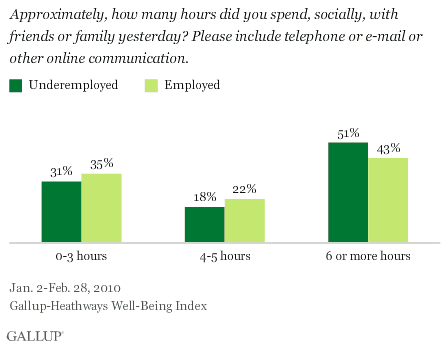
The Bottom Line
With approximately 20% of Americans currently underemployed, the daily negativity this group experiences could have an impact on their lives now and in the future. Gallup has previously reported that underemployed Americans report spending substantially less than the employed and that the majority of the underemployed are not hopeful about finding a job, trends that are sure to contribute to daily worry, sadness, stress, and anger.
Gallup data also illustrate that, at least in terms of evaluative wellbeing, those working part time but wanting to work full time are more similar to those who are unemployed than they are to those who are fully employed. This finding highlights the need to move beyond traditional metrics such as unemployment and to adopt measures such as underemployment, which are more inclusive of the struggles Americans face each day. Still, although unemployment might isolate some individuals from social networks, the underemployed are more likely than the employed to spend at least six hours of time per day with family and friends, perhaps combating some of the stressors of underemployment.
Gallup tracks the U.S. workforce daily and will continue to monitor the wellbeing of the more than 30 million underemployed Americans.
Learn more about the Gallup-Healthways Well-Being Index.
Survey Methods
Results are based on telephone interviews with a random sample of 39,255 national adults, aged 18 and older, conducted Jan. 2-Feb. 28, 2010. For results based on the total sample of national adults, one can say with 95% confidence that the maximum margin of sampling error is ±1 percentage points.
Interviews are conducted with respondents on landline telephones (for respondents with a landline telephone) and cellular phones (for respondents who are cell phone only).
In addition to sampling error, question wording and practical difficulties in conducting surveys can introduce error or bias into the findings of public opinion polls.
About the Gallup-Healthways Well-Being Index™
The Gallup-Healthways Well-Being Index measures the daily pulse of U.S. wellbeing and provides best-in-class solutions for a healthier world. To learn more, please visit well-beingindex.com

